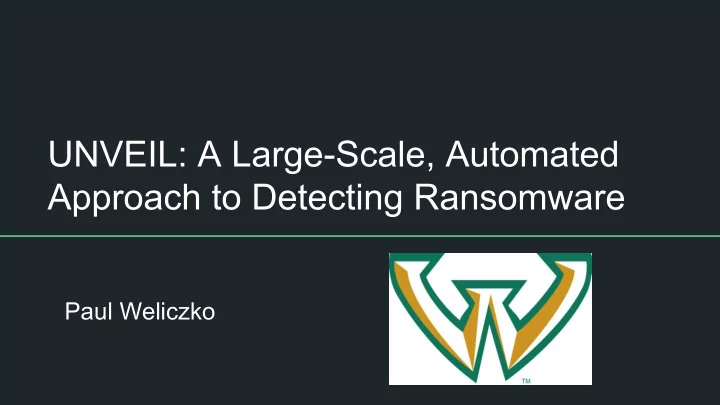

UNVEIL: A Large-Scale, Automated Approach to Detecting Ransomware Paul Weliczko
https://arstechnica.com/information-technology/2012/11/mushrooming-growth-of-ransomware- extorts-5-million-a-year/
https://www.2-spyware.com/remove-cryptowall-virus.html
Outline ● Introduction ● Motivation ● Background ● UNVEIL Design ● Implementation ● Evaluation ● Discussion and Limitations ● Questions
Introduction ● Ransomware’s resurgence in popularity ● Use in combination with cryptocurrencies ● Successful attack requires tampering with a user’s files or desktop ● UNVEIL generates an artificial user environment and detects when ransomware interacts with user data
Motivation ● One of the largest security threats on the Internet today ● CryptoWall 3.0 caused $325M in damages ● Sony ransomware attack ● Potential to be highly profitable CryptoWall Images from https://www.secureworks.com/research/cryptowall-ransomware
Background ● Dynamics of Ransomware ● Evading detection, propagation, and attacking users (like other malware) ● Attack Multi-infection or process injection ○ Send user info to 3rd party ○ Encrypt files ○ Establish communication with C&C servers ○
Just Ransomware Things Persistent desktop message ● API functions (ex. CreateDesktop()) or HTML ○ Indiscriminate encryption and deletion of the user’s private files ● aggressive encryption, deletion or overwriting ○ encryption keys generated locally or remotely ○ Windows API functions, secure deletion via Windows Secure Deletion API ○ Selective encryption and deletion (by size, date, accessed, extension) ● To avoid detection, files are encrypted selectively ○ Simple- view access date; More advanced- open app and view recently accessed; Even more ○ advanced- inject mal. code into any Windows app
UNVEIL Design: Detecting File & Screen Lockers ● Detecting File Lockers ○ Monitors the filesystem activity ● Generating Artificial User Environment ○ Malware can detect artificial environment ○ UNVEIL creates user data that seems real (valid content, files paths, time attributes, etc.) ● Detecting Screen Lockers ○ Takes screenshots outside of analysis environment to prevent tampering ○ Uses Tesseract-OCR, open source OCR engine, to extract text from the ransom notes in the images ○ Also compares the screenshots before and after sample execution and compare images
Implementation ● Prototype built on top of Cuckoo Sandbox ● Used 56 VMs running Windows XP SP3 ● Anti-evasion measures ○ Changing IP address range and MAC addresses ● Limited access to the Internet ○ Filtering and limiting IRC, DNS, and HTTP traffic so samples could communicate with C&C ● Each sample ○ Executed 20 minutes ○ Filesystem IO traces recorded ○ Pre- and post-execution screenshots taken
Evaluation ● 2 Experiments: Detect known ransomware & unknown ransomware ● FP=0% and TP=96.3% ● Able to distinguish between benign apps (ex. 7-zip, AESCrypt, etc.) and ransomware
Discussions & Limitations ● Automated, practical and useful detection on large, real-world dataset ● Malware authors observe defense and adapt ● Fingerprinting Artificial User Environment ○ Can use heuristics to look for specific behavior from user before locking the desktop ○ Makes detection easier since it requires hooking specific functions in the operating system ○ Delay attack and also give more time to detect the attack ● Shuffling Instead of Encrypting ● Modifying Language in Ransom Note ● Stalling code to prevent analysis ● Kernel level ransomware (currently most is user level) ○ More sophisticated and higher barrier to entry
Questions
Recommend
More recommend